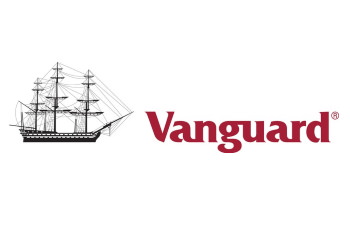As far as cheap exchange-traded funds go, Vanguard is the standard-bearer.
It offers investors a varied selection of funds to pick from. The variation is enough to build a substantial yet diversified portfolio.
Quick Navigation
Top 10 Vanguard ETFs
Vanguard S&P 500 ETF – VOO
 A Vanguard account gives you access to commission-free trading. It lets you buy and sell Vanguard-only ETFs without paying the provider a dime. And Vanguard S&P 500 ETF is one such fund that enables you to save more and spend less.
A Vanguard account gives you access to commission-free trading. It lets you buy and sell Vanguard-only ETFs without paying the provider a dime. And Vanguard S&P 500 ETF is one such fund that enables you to save more and spend less.
This fund tracks the S&P’s 500 index (market-cap-weighted), which can help you track the performance of large-cap stocks in the US. VOO falls in the Morningstar’s large blend category, which includes ETFs that hold large-cap domestic stocks.
Since the fund is market-capitalization-weighted, more extensive holdings lead to better performance as their market cap increases. In VOO’s case, these would be their large-cap companies – worth more than $10 billion, including Apple, Microsoft, Facebook, Amazon, and JP Morgan. There are also a few mid-cap companies or those with a market value of less than $10 billion).
You don’t have to pay upfront or make a non-negotiable investment as you would with Vanguard’s mutual funds. You have to own one share, and that can cost you as little as $1. As for the expense ratio for VOO, it’s below average. According to Morningstar, it’s the lowest you’ll find in ETFs of this category – at 0.03 percent to be precise.
Vanguard Total Bond Market ETF – BND
To build infrastructure or to grow their company, governments and corporations take loans from investors. This loan is represented in the form of a bond. Bonds are fixed-income securities that provide their holders with a fixed income.
But since it’s challenging to keep track of these debt securities, investors resort to bond market funds. Vanguard Total Bond Market ETF is one such fund. It lets you invest in both short-term corporate debt as well as long term US treasuries debt.
The fund boasts a selection of no less than 8500 securities, including treasury bonds, agency bonds, foreign bonds, and corporate debts. All of these are rated investment-grade, which means the bond will get repaid – or at least there’s a very high probability of that.
To give you an idea about how it works, about 70% of the bonds received a ranking of AAA – the highest-grade rating for any bond.
BND is a Bloomberg Barclay’s US Aggregate Bond Index tracker and the same as the VOO mentioned above. BND is market-capitalization-weighted, which means it facilitates high-level holdings.
As for the duration – which points to how the bonds will react to interest rate fluctuations, the bonds will lose their value by 6 percent for every 1 percent increase in the interest rate. It is the same as any bond fund; you will lose money during the periods of interest rate hikes.
The expense ratio for the fund is 0.04 percent, which is supposed to drop to 0.03 soon, which will make this inexpensive fund the lowest cost in its category.
Vanguard Emerging Markets Government Fund ETF – VWOB
If you’re an investor looking for better yields, this fund could be the right fit for you. It invests in emerging markets. Or more specifically, bonds issued by the US government in these emerging markets. These markets include South American and Middle Eastern countries.
80 percent of the fund’s assets are invested in the bonds mentioned above. The expenses for VWOB is 0.3 percent, which is well below average.
Vanguard Information Technology ETF – VGT
Technology is perhaps the only sector that is not simply ever-growing but growing exponentially. Other sectors like utilities, finance, or healthcare fluctuate with the market environment. Some perform better with interest rate hikes, for instance, the financial industry, while others, do not fare so well.
But technology permeates every part of our lives. It’s ubiquitous, and it is also part of these other sectors I mentioned. This reality underscores why technology EFTs should be part of any investor’s portfolio. And if you are cost-conscious looking for inexpensive funds in this space, Vanguard’s Information Technology ETF is the lowest-cost fund in this category.
The portfolio features stocks from major tech giants and chip manufacturers, including Apple Inc., Google’s parent company Alphabet, Facebook, Microsoft, Intel, and payment processing companies like Visa and Mastercard.
The fund itself falls in Morningstar’s category of technology, which includes mutual funds and ETFs in the technological sector. It is a tracker of MSCI US IMI Information Technology 25/50 index – which in turn tracks the performance of different companies in the space. The fund invests in 338 quality holdings made up of large-cap US companies.
The fund makes use of passive indexing, which replicates how the benchmark performs. And because of that, the fund’s expense ratio is the lowest in this category, which is a below-average 0.10 percent.
Vanguard Energy ETF – VDE
Small to large cap US energy company stocks make up this fund. It’s a non-diversified fund that tracks the MSCI US Investable Market Index. The energy sector is more than promising, given our dependence on fossil fuels.
Companies like Exxon Mobil, Chevron Corp, and ConocoPhillips are some of its top holdings. The expense ratio for this fund is 0.10%.
Vanguard Small-Cap ETF – VB
If you’re a novice investor and you’re still trying to grow and build your portfolio. One of the better ways to grow is to invest in small-cap stocks. The reason behind investing in small-cap holdings is their potential for exponential growth.
Since they’re valued at less than $2 billion, they can generate revenue faster, which directly translates into higher growth for you.
Vanguard Small-Cap ETF operates on that principle. It features more than 1200 small-cap holdings. Since the portfolio is extensive, the fund safeguards your portfolio in case a single stock plummets.
Unlike most EFTs where only a handful of companies represent a significant chunk of the portfolio, VB has a very diversified index of the stocks. Each stock in the index is held in the same proportion. The fund invests the assets in all of them.
The fund is a CRSP US Small-Cap Index tracker, and its holdings include Atmos Energy, WP Carey, Burlington Stores, iDEX corp. The expense ratio is 0.06 percent.
Vanguard Large-Cap ETF – VV
Large-cap or big-cap are companies with their market capitalization value at $10 billion or more. The CRSP US large-cap index measures the stocks of these companies. And VW tracks this index. The index represents the large US companies that comprise almost 85% of the total market cap.
Its holdings include titans like Microsoft, Apple, Exxon Mobil, Facebook, and Alphabet. The assets are worth at least $23 billion.
Vanguard REIT Index – VNQ
REITs are trusts that invest in real estate and are required to pay out at least 90 percent of their revenue in the form of dividends, and that’s precisely why funds like this one offer high yields. When compared to the S&P 500 fund, the yield is twice as much.
The fund is a tracker of MSCI US Investable Market Real Estate and is non-diversified. The expense for VNQ is 0.12 percent.
Vanguard Total International Stock ETF – VXUS
This fund invests nearly all its assets in non-US large caps. The majority of the fund’s holdings are in developed countries, but there’s also a small share of them in developing ones. These include Samsung, Alibaba Group, Toyota, and Nestle.
The expense for VXUS would be 0.09, which Morningstar ranks as below average.
Vanguard High Dividend Yield ETF – VYM
To benefit the significant shareholders of a company (such as the executives), the company pays all its shareholders a sum after regular intervals. These payouts are called dividends.
More often than not, you’ll receive $1-2 per stock quarterly, but the more shares you hold, the more you get paid. And so, the payments add up. It’s fairly straightforward. Depending upon the company, your investment can return fivefold over the decades.
If you’re a retiree, you’re probably already familiar with these funds. Typically, retirees make use of dividends as their primary source of income. And if you’re looking for a fund that invests in large-cap holdings to provide you with better dividends, look no further than Vanguard High Dividend Yield ETF.
You might be swayed by ETFs, which promise a better dividend yield, but you also have to consider the volatility and growth potential. VYM minimizes risks by mostly investing its assets in large-cap stocks including Johnson & Johnson, JP Morgan Chase, Microsoft, AT&T corp., Verizon Communications Inc., and Exxon Mobil among 420 other large-cap US-based companies.
Since the fund is market-cap-weighted, these holdings provide 50% more yield than the market average. However, the stocks tend to overconcentrate, which leaves the fund vulnerable to risks and underperformance.
The total market value of the fund is $23.8 billion, and you can expect a dividend yield of up to 3.1% and an annual return of 7.09%.
As for the fee, Vanguard utilizes passive full-index-replication, which slashes the costs, bringing the expense ratio down to 0.06 percent. This rate is the lowest cost in this category and well-below average.
Vanguard Alternatives
Vanguard is hardly the only place to invest in ETFs. Three of its top competitors are:
M1 Finance –
TD Ameritrade
E*Trade –

Leave a Reply